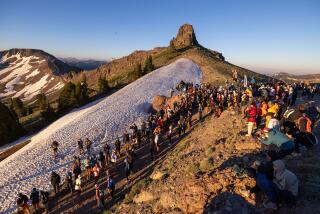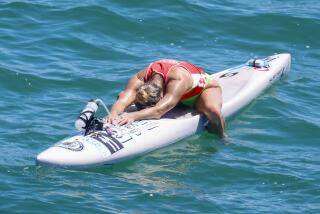Hogan Will Be Riding Against the Men--and Herself
Seana Hogan is the only woman entered in the Race Across America, but don’t for a minute think she won’t have competition in this torturous transcontinental bicycle race.
Once again, Hogan will be challenging the men when the 17th edition of RAAM rolls out of Irvine today on the way to Savannah, Ga., 2,906 miles to the east. Hogan, the women’s division winner in five of the last six nation-spanning races, is hoping to become the first overall winner who happens to be female.
It’s a longshot, according to race director Michael Shermer, but Hogan has been pursuing it for the past few years and she certainly would be the woman to do it.
This is, after all, the same woman who was the overall leader through the first three or four days the last three years. And she holds the overall records for riding from San Francisco to Los Angeles and Seattle to San Diego.
But RAAM is tough, an endurance grind that requires riders to stay on the bike more than 20 hours a day, through desert heat, driving rain and bleary-eyed hallucinations. Can Hogan defeat the men?
“Realistically, probably not,” Shermer said, “but it certainly is an interesting goal and it wouldn’t bother me in the least.
“I think it would be terrific as the race director. It would bring extra attention to the race.
“But we have seven former winners in the race this year and I can’t imagine the guys are going to let that happen.”
In 1995, Hogan set the women’s transcontinental record, winning the women’s division of RAAM in 9 days 4 hours 2 minutes. She finished 8 hours 3 minutes behind the men’s winner, Rob Kish.
Does she feel better prepared this year to get closer to her goal?
“I don’t want to jinx it,” Hogan said last week by telephone from her office in San Jose, “I don’t want to say.”
Hogan will say that competing against men comes with a cost. “I pay a price and it’s all subtle,” she said. “It’s just subtle things, subtle treatments. It’s hard to explain.
“I don’t want to give exact stories because I don’t want to be yappa-yapping.”
Pressed for details, Hogan cites scrutiny of her record 401-mile ride from San Francisco to Los Angeles in 1996. After breaking the record by more than an hour, it was discovered that her crew vehicle tripped signal lights ahead of her in San Francisco.
The Ultramarathon Cycling Assn. wouldn’t recognize the record.
“I thought, ‘Well shoot,’ ” Hogan said. “ ‘instead of putting my energy into fighting it politically, I’ll just go out and do it again. The hell with them.’ ”
The next week, she finished 10 minutes faster, in 19 hours 11 minutes, a record that still stands (1 hour 29 minutes faster than the men’s mark).
Shermer, himself a former ultracyclist and three-time RAAM finisher, doesn’t agree that the men treat Hogan poorly because she’s a woman.
“She and I have talked about this and we agree to disagree,” said Shermer, who held the Seattle-to-San Diego mark before Hogan broke it. “I think she takes some hits, so to speak, by virtue of being one of the top riders not by virtue of being female.
“When I talk to the men during the race, when she’s ahead of them, I say, ‘God, does this bother you? You’re being beaten by a skirt! Come on.’
“ ‘Aw no,’ they say. They don’t care, they actually don’t. It doesn’t bother them. Seana is just another rider, just a really good rider.”
When Hogan started riding, she was merely a regular commuter, pedaling about eight miles a day to class at San Jose State.
She continued to ride for transportation after moving on to graduate school at UC Berkeley and later when she got a job as a mainframe software engineer at IBM. At IBM, she started riding with a group that rode 100-milers.
Hogan, a natural athlete who swam at the national age-group level in high school, soon was escalating her mileage.
A double century (200 miles) in 1991 was followed a few months later by a 400-mile ride she finished in less than 24 hours. Soon after that she crashed during a descent during a late-night training ride, breaking her collarbone, her hip and eight ribs.
After a month in a wheelchair, she started training for Furnace Creek, the 500-plus mile race across the California desert and a qualifier for the Race Across America. Six weeks after leaving her wheelchair, Hogan won the women’s division of the Furnace Creek race.
By that time she was hooked on ultramarathons. In 1992 she won the first of four consecutive RAAM women’s titles. “The training part is really what I enjoyed,” she said, “and as long as I was training I thought I might as well race.”
Hogan’s training is a mix of daily commuting (40 miles round trip) and lunch hour riding (30 miles) and a Saturday ride of about 200 miles.
It’s a schedule that allows her to juggle her job and spend plenty of time with her 7-year-old son, Alex, whom she is raising alone after a divorce.
Hogan is one tough single mother.
“I guess everyone has their cross to bear,” Hogan said. “If I wasn’t a single mom, it would be something else. Of course, I don’t consider Alex a cross to bear. Raising kids is a part of life. Sometimes it’s easy, sometimes it’s hard.”
As the only woman entrant in this year’s RAAM, Hogan is assured of the $10,000 first-place prize if she finishes. If she beats all the men, she will win a $10,000 bonus.
So does she believe she has a chance?
“I think I do, but we’ll just have to see,” Hogan said. “Different things come up and there’s also the social stigma of being a woman. It’s hard to explain, you just have certain beliefs that are ingrained in your head.
“When you get taken down to your mental core out there on your last few days of RAAM, it’s hard to overcome the stigmas.”
For instance, Hogan says, in 1995 she led Gerry Tatrai, the 1993 RAAM winner, almost the entire race. But Tatrai, who finished third, zoomed past her late one night entering Georgia with 400 miles to go.
Hogan let him go, believing that the chase was futile because Tatrai was a man and therefore stronger.
“Early the next morning,” Hogan recalls, “the sun was just coming up, and he passed me again. Which means I passed him. He was on the side of the road someplace hiding while I passed him because he didn’t want to give me the mental edge of passing him.
“It turns out in the end he beat me by only half an hour. I learned a lot from that about myself. I just let him have it, essentially. I didn’t give him any kind of fight because he’s a guy and I’m a woman.”
Hogan hopes she has eliminated that thinking.
“I won’t be able to tell until I’m out there. I like to think that I’m over it. I like to think that I have learned, but those things run deep.
“I think women have their own little glass ceilings, their internal glass ceilings.”
(BEGIN TEXT OF INFOBOX / INFOGRAPHIC)
RACE ACROSS AMERICA
The 17th Race Across America ultra-cycling competition begins Thursday, when more than 20 men and women riders begin a nonstop 2,900-mile race from Irvine to Savannah, Ga. Solo and tandem riders leave at 9 a.m. from the Holiday Inn Select. Four-person relay teams begin 9 a.m. Sunday.
The Facts
Total distance: 2,906 miles
*
Average speed
Solo: 15 mph with sleep, 18 mph without sleep
Team: 25 mph
*
Calories burned: 10,000 daily
*
Average mileage
Solo: 350 miles/day
Team: 550 miles/day
*
Average sleep
Solo: 90-120 minutes/24 hrs., skip sleep first night
Team: 3 hrs/24 hrs
Website https://www.RAAMonline.com
The Route
Highest elevation
Cloudcroft, NM: 8,650 ft.
*
Lowest elevation
Salton Sea: 100 ft below sea level
*
Highest temperature
120 degrees F Palm Desert
*
Lowest temperature
40 degrees F nightfall/Arizona Mountains
More to Read
Go beyond the scoreboard
Get the latest on L.A.'s teams in the daily Sports Report newsletter.
You may occasionally receive promotional content from the Los Angeles Times.










